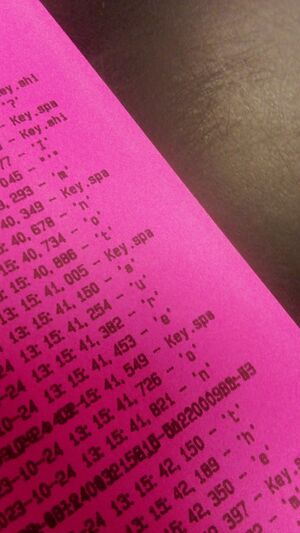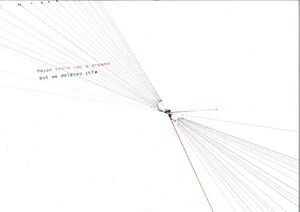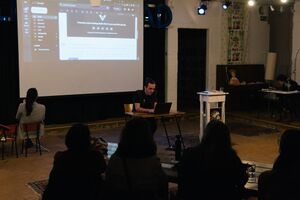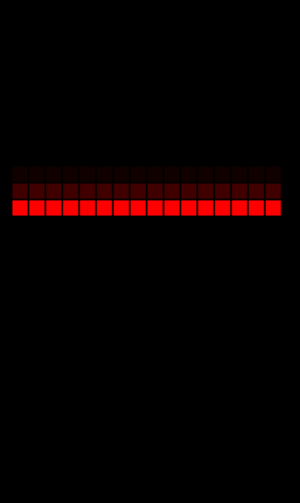User:Ssstephen/projectproposal
What do graphic designers do all day and why do they do it and what does "graphic design" even mean?!????!!1!?
What do you want to make?
I want to make a piece of research about graphic design that involves ethnography, toolmaking and performance as research methods. I want to examine how a designer spends their time in everyday life, as a way of uncovering the worldviews, belief systems, mythologies and ideologies of these practitioners.
What do graphic designers do all day and why do they do it and what does "graphic design" even mean?!????!!1!? is an assessment of what the term "graphic design" means to its practitioners today. Through experimental ethnographic research methods and the development of reflexive tools, the project seeks to highlight and question the boundaries that exist around this apparent category. The research focuses on my own practices as well as other people and groups that identify with "graphic designer" as a label. The research will be both conducted by and shared with interested parties in the form of the tools themselves, as well as a series of performances. There is no strict distinction between the research and its publication. The tools will be released in an iterative cycle throughout the process of the project, and the research is conducted through the performative use and development of these tools.
How do you plan to make it?
This research is carried out in three intersecting methods: experimental ethnographic research, reflexive tools, and performative research. Keylogging, performance of personal work habits, interviews about the manual work of "immaterial labourers", and devices that connect seemingly unrelated practices will be combined in order to uncover less obvious and less discussed aspects of what a designer is and does in their daily life, as entry points to the worldviews, belief systems, mythologies or ideologies of its practitioners. All of the methods will be developed in an iterative process that will increasingly focus on findings from the previous prototypes. The research will take into account its own publication as part of one process.
1. Experimental ethnographic research methods: I have been documenting my own practices as a graphic designer for three months, and will continue to do so for the duration of the project. I am experimenting with different ways of doing this, many based on technical observations of my interaction with my tools, primarily my laptop computer and the software on it. I plan to expand the methodology further to get a wider view of the practices. I will document the practices of others, through interviews and using reflexive tools developed for this purpose. I will conduct interviews with designers, architects, musicians, etc. in Ireland, the Netherlands, and other relevant places (for example on fiverr.com). I will record the interviews. I will have prompts to open the discussion such as reading material and weird tools to try with them. I will carry out auto-ethnographic research using experimental methods such as mouse tracking and unusual annotation methods. I will share the results of this research as a series of interactive publications (tools) with a small but selected audience of people who are involved in these processes and who would benefit from it.
2. Reflexive tools: Software and hardware tools that explore the boundaries of "graphic design" as a category. For example at the boundaries between graphic design and other disciplines. At the boundaries between work and play, or between design and art. These tools malfunction in order to explore what it even means to be working. The tools aim to highlight what a graphic designer does by interacting with their user in ways that the designers standard tools do not (for example an interface to connect musical instruments to the designers workflow), or conversely by amplifying how the designer usually interacts with their tools (for example a keylogger to celebrate and focus on the use of the keyboard). The tools are digital in nature and involve software and hardware interventions into the graphic designers work.
3. Performative research: I see all the methods above as having a performative element. For example the ethnographic-slash-performative act of answering my emails on a large screen in front of an audience, research which was carried out as part of this project at Leeszaal, Rotterdam West on November 7th 2023. By showing directly the work practices of graphic designers to an audience, or their interaction with the tools mentioned above, I am publishing through performance the daily activities of designers and my aim is to show these practices without the conventional lenses they are seen through. To be contrasted for example with how graphic design is presented on behance.net or in a bookshop, this performative approach will highlight the mythologies and practices of the graphic designer.
What is your timetable?
Although the process is mostly iterative, I do expect it to develop over the eight month period of the project.
- November: Initiate autoethnography and gather preliminary data. Early prototypes of performances and tools.
- December: Conduct interviews with designers, review findings, and plan for tool development.
- January: Prototype reflexive tools which explore boundaries of what "graphic design" is. Publish early and often, to designers.
- February: Make connections with other disciplines, shift to "performative" or "self-publishing" tool development.
- March: Based on findings so far, iteratively prototype tools in line with emerging findings.
- April: Create and gather content of final publication which reviews both the methods and findings of research developed.
- May: Create this publication and final iterations of tools. Rehearsals of performance.
- June: Finalize publication of research directly to the relevant public and also through performance at the graduation show.
The final publication I expect to look less like the "interviews" and "observations" that the research currently takes, and more like an instrument that can be used for a performance. A shift in function of what I'm making that still engages with the same subject matter on the level of tools.
Why do you want to make it?
To explore why designers make design, based on Clifford Geertz's ideas of why humans make culture: "to affirm it, defend it, celebrate it, justify it and just plain bask in it" (Geertz, 1973). This exploration will also involve less constructive actions like participating, dissociating, questioning, protesting, destroying and disregarding. There is a disconnect between the narratives about "graphic design" and the effects it is known to have on its audiences, practitioners, and society in more general terms. I am attempting to "loosen the object" of graphic design (Berlant, 2022), to make the definition less defined and maybe more useful or easier to engage with. This shit could be better. Its urgent for the people being exploited by it, to break the inequalities it serves to maintain, to expose what it hides, to improve things that are definitely working but not in a good way.
Who can help you and how?
Joseph and Manetta, xpub staff, have been helping with the development of the tools, and will continue to be invaluable. I will be sharing these tools with other practitioners of graphic design as mentioned in the How do you plan to make it? section above, my aim is to involve designers who find themselves in various worlds as this seems like a useful way to see different world views. So I am aiming for variety in experience, geographic location, economic position, design style, sub-discipline, political views, age, gender, ethnicity, religious beliefs. People involved in other practices (disciplines) who could help me explore crossing these boundaries including musicians, architects, coders, artists, and other fields that have some cross over with the worlds of the graphic designers. Many of these people will come from Ireland as I have an established network of collaborators there. Many will also come from Netherlands and Belgium, people and organisations I have met through my time here in Experimental Publishing.
Relation to previous practice
In the first year of Experimental Publishing I was involved in several projects which relate to the subject matter and methodologies of this project. In Garden Leeszaal (Special Issue 19) we tore up books which was an important moment of disrespecting print culture. In Console (Special Issue XX) there were studies of labour, play and their mythologies, for example the mod of Tetris shown here which involves no labour. tty (Special Issue 21) was a fragmented engagement with the interfaces of computers as a method of exploring human behaviours and belief systems.
I have worked as a graphic designer for about a decade; in studios, as a freelancer, making things I'm proud of, earning money, staying up late, getting burnt out, being confused. This project is a reflection on that period and an expression of my feelings about the discipline. I have also worked as a musician, a theatre maker, a teacher, a web developer. This project will hopefully bring the fuzziness of the boundaries around "graphic design" into focus, without expecting it to be clear.
Relation to a larger context
From personal experience and anecdotal evidence from others in the context of design studios and institutions I was involved with in Ireland, as well as an increasing literature on the topic, there are obviously some problems with our understanding of design today (Pater, 2021, Lorusso, 2023). People, including me, are reassessing what graphic design even is and also what it can be (Libre Graphics Research Unit, 2012). The project also attempts to highlight some problems in the broader context of labour rights and how time is structured (Hu, 2024) for users and servers who relate to and struggle under systems and labels like "self-employed", "freelance", "creative". This makes me a little uncomfortable as most of these workers including me come from an extremely privileged position of literal wealth and other advantages which allow them to operate in these fields. I dont want to suggest their struggles to be worse than or even comparable to those of many others people currently on this planet. But the topic relates to larger societal developments of precarity that are worth examining and challenging, so I will do this from my own practice and experiences within the creative industries.
References/bibliography
Berlant, Lauren Gail. On the Inconvenience of Other People. Duke University Press, 2022.
Geertz, Clifford. The Interpretation of Cultures: Selected Essays. Basic Books, 1973.
Hu, Tung-Hui. Digital Lethargy: Dispatches from an Age of Disconnection. MIT PRESS, 2024.
Libre Graphics Research Unit. 16 Case-Stories Re-Imagining the Practice of Lay-Out. 2012, https://gitlab.constantvzw.org/lgru/co-position-catalog.
Lorusso, Silvio. What Design Can’t Do: Essays on Design and Disillusion. Set Margins’ publications, 2023.
Pater, Ruben. Caps Lock: How Capitalism Took Hold of Graphic Design and How to Escape from It. Valiz, 2021.




